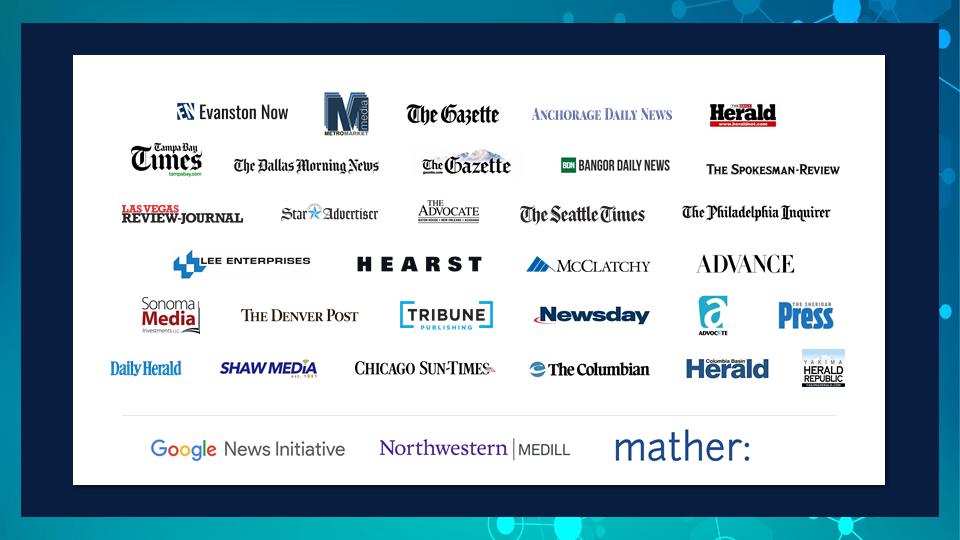A Medill study of data from a business weekly publication shows the value of regular readers over pageviews.
Business Weekly Data Show Value of Regular Readers
This article was originally published on Northwestern University’s Medill Local News Initiative website and is republished here with permission.
How should a weekly business magazine determine the long-term value of its subscribers: by how many stories they read or the number of times they visit the website? Contrary to the usual preoccupation with page views, it turns out that frequent readers are more valuable than those who only stop by occasionally and read a lot, according to a recent analysis of reader data from the Medill School of Journalism, Media, Integrated Marketing Communications.
For the business weekly Medill studied, “Having readers who read more often is 10 times more important than having them read more articles,” said Medill Spiegel Research Center Research Director Edward Malthouse, Erastus Otis Haven Professor of Integrated Marketing Communications, who oversaw the first-of-its-kind analysis using anonymized data from the Midwestern business publication. “Regularity is more important than intensity.”
Malthouse led the analysis as part of his work with the Medill Subscriber Engagement Index, a new tool created in conjunction with the Medill Local News Initiative, The Medill Index, launched last year, enables participating news outlets to anonymously track the behaviors of their digital subscribers. It identifies content that correlates with retention and allows local news organizations to benchmark their audience metrics with peers across companies around the nation. To date, 103 publications are participating in the Index and dozens more are in the process of being onboarded. according to Tim Franklin, Senior Associate Dean and John M. Mutz Chair in Local News at Medill.
This latest analysis considered millions of page views by digital subscribers of the business weekly over six months from July through December 2021. (The publication is printed weekly but updates its site daily). The importance of building a reading habit among subscribers is consistent with findings from other news publications, according to Arvid Tchivzhel, managing director of digital services at Mather Economics, a global media consulting firm that specializes in subscriber management and data analytics. “Habit is more important than intensity,” he said. “I’d rather have someone read one article a day and come back than someone who reads six articles at a time and doesn’t come back for months.”
The analysis also found that a few coverage areas drove most of the magazine’s regular readership. Topping the list were stories about commercial and residential real estate. Second place belonged to a long-time political columnist. Healthcare stories came in third. The first finding wasn’t particularly surprising because real estate coverage has been a long-time pillar of the magazine, said the publication’s publisher, but the importance of the healthcare-related coverage was something of a revelation. “It was a pleasant surprise,” the publisher said. “We know this is a big healthcare market, but we didn’t have a lot of data around how many subscribers are there because of that.”
“This research is significant because it shows the key to success in keeping readers is building habit, whether you’re a general interest metro daily or a weekly business publication with a more upscale audience,” Medill’s Franklin said. “The formula is the same. Do things that regularly lead readers back to you. Why is that important? The cornerstone of the new business model is reader revenue. That means reader retention is paramount.”
Political Columnist Drives Readership
The magazine also recognized that its political columnist was a big draw for readers. That columnist is “worth his weight in gold,” Malthouse said, and is responsible for a big cluster of subscribers that the analysis termed “political junkies.” The publication recently hired a second politics writer to augment its coverage of the intersection of public policy and business. The magazine’s publisher said he appreciated the finding because it “affirmed some of our hunches and gave us more confidence about doubling down in those areas. This will help us refine some of our audience strategies around more casual readers. We know they like our content, but we need to figure out how to get them to be more engaged as paying subscribers.”
Once a publication knows what type of content attracts readers, it can start adjusting its home page to emphasize those subjects rather than just highlighting the latest breaking news, Tchivzhel added. That requires changing a scoop-oriented mindset, which is a hard transition for some long-time journalists and editors to make.
“Rather than ‘all-breaking news, all the time,’ you move to a balance of content that attracts your most loyal readers, the ones who will subscribe,” he said. “You still want to have breaking news on the home page, but you can do that with a breaking-news widget. You put the big photo and headline on the content that serves most of your readers.”
The information about what content is of most interest to specific subscribers can also be used in a digital newsletter strategy to drive readers to a website, he added. That’s good news because the business magazine already has a newsletter strategy, the publisher said.
Tchivzhel was encouraged when he heard that the publication had recently hired a second political writer. “Publications should be investing in things that work. It actually supports the best of journalism. The people who are willing to pay for content are engaged by good journalism and content that makes an impact.”
He also suggested a strategy for the “teaser” links to related content that appear at the bottom of a story or column. Instead of linking to past political columns, Tchivzhel recommended linking to real estate or healthcare news because of the synergies between those readership areas.
Even though the publication specializes in business coverage, it also runs occasional reviews of restaurants and cultural events such as art exhibitions and concerts. The analysis found that articles about restaurants and dining ranked in the top four areas of page views by prospective readers, those who visit the website but aren’t yet subscribing. That makes sense, says Tchivzhel, because readers of a specialty business publication are likely an affluent audience with disposable income and an interest in arts and culture.
That insight is useful because it suggests additional content areas that could be built out, the publisher said. “We’re really trying to use the data to see how far we can expand our audience outside of traditional business. We see some potential opportunities if we put more resources behind those areas.”
Medill’s Malthouse said this latest data analysis shows what works for the publication under review, and the findings may not apply to others that have individual recipes for success.
Not every business weekly around the country should feature a political columnist and invest in restaurant reviews, said Michael Silberman, senior vice president of strategy at media consultancy Piano.
“Somebody who is only looking at article pages and not going to the home page, they are less likely to subscribe. They probably got there from an email they read,” Silberman said. “Because of the way paywalls work, you may have very limited ability to read even if you’re visiting several days in a row. They may look like they are loyal, but they are just trying to read. They may only be loyal to clicking on the website.”
Silberman suggests that publications take a variety of actions to ensure reader loyalty. Those include a comprehensive “onboarding” process for new subscribers that includes a set of messages highlighting exclusive content and website navigation. He also recommends emailing daily round-up newsletters to subscribers and making sure that the content that drives frequency is highlighted. “Putting all those pieces together is really important,” he said.
Malthouse agrees, and added that the onboarding process should “show subscribers how to get the most out of their subscriptions,” he said. “If they receive value from the subscription, then they will continue to pay for it.” As publications continue to shift from ad-supported business models to reader-supported models, he noted, engaging subscribers becomes increasingly imperative.
Students in the Masters of Science in Analytics program at Northwestern’s Robert R. McCormick School of Engineering and Applied Science helped analyze the data and presented findings to the business publication.
Susan Chandler is a freelance journalist based in Chicago who previously taught as an adjunct faculty member at the Medill School of Journalism, Media, Integrated Marketing Communications at Northwestern University.
Get in touch if you would like to learn more about the Medill Subscriber Engagement Index and join over 100 leading brands already participating!
For more information about the Subscriber Engagement Index or to get involved, please contact Tim Franklin at timothy.franklin@northwestern.edu


